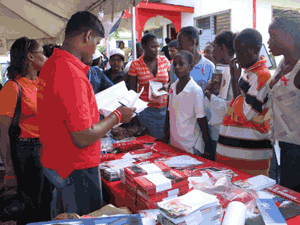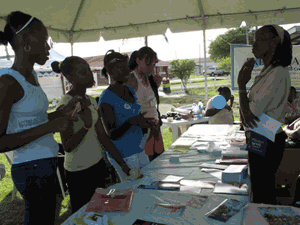THE Government of Guyana, in its efforts to prevent the spread of HIV/AIDS has embarked on several sensitisation campaigns aimed at promoting awareness of the disease among the population.  Testing sites have been constructed throughout the country and government provides free treatment and counselling to persons who are infected with the virus. Additionally, regional officials in Guyana continue to benefit from countrywide HIV/AIDS training workshops conducted by the Ministry of Local Government and Regional Development in keeping with its work plan to build capacity at the local level.
Testing sites have been constructed throughout the country and government provides free treatment and counselling to persons who are infected with the virus. Additionally, regional officials in Guyana continue to benefit from countrywide HIV/AIDS training workshops conducted by the Ministry of Local Government and Regional Development in keeping with its work plan to build capacity at the local level.
These Peer Educators Training workshops aim to educate employees to become peer educators in their various regions and to empower regional officers with the necessary skills to become peer educators who will then proceed to train other persons in their respective regions. The programme is a collaborative effort between the government and the World Bank which aims to sensitise persons on the HIV virus.
To support this effort, the Ministry of Labour, Human Services and Social Security established a National HIV and AIDS Workplace Policy that aims to promote awareness of HIV and AIDS and prevention measures among all employers, employees, Trade Unions and government with focus on safety, health, protection and support for employees already living with and affected by HIV and AIDS.
The main objectives of this policy include protecting people living with HIV and AIDS from stigma, discrimination and unfair judgment at their workplaces.
Government and its social partners have acknowledged the threat and impact of the disease on decent workers and have recognised that the workplace is an important entry point of mitigating the impact of the deadly disease on workers and their families.
It was against this background, and with the support of national and international partners that the National HIV and AIDS Work Place Policy was developed.
As the fight against the pandemic intensifies, HIV/AIDS cases in Guyana have been vastly reduced along with the rate of deaths from this disease and over 350,000 persons have been tested over a five-year period. Premiere health agencies and organisations have recognised Guyana as no longer a threat of having a widespread HIV/AIDS epidemic, and the country is no longer listed as a High Prevalence Country when it comes to HIV and AIDS.
Government has strengthened the surveillance system to design interventions for HIV/AIDS reduction while the Prevention of Mother to Child Transmission programme (PMCTP) is producing results.
 There is increased access to appropriate Sexually Transmitted Infection (STI) diagnosis and management as a key prevention strategy along with a national plan to increase access to voluntary counselling and testing (VCT). AIDS awareness and education training at worksites is part of public education on HIV/AIDS with rigorous blood screening for HIV and other infectious markers.
There is increased access to appropriate Sexually Transmitted Infection (STI) diagnosis and management as a key prevention strategy along with a national plan to increase access to voluntary counselling and testing (VCT). AIDS awareness and education training at worksites is part of public education on HIV/AIDS with rigorous blood screening for HIV and other infectious markers.
The Provision of free HIV services including antiretroviral therapy for HIV-positive patients lends additional support for persons living with HIV (nutritional, psychosocial, economic and others) and there is also support for orphans and vulnerable children.
The Millennium Development Goal for HIV/AIDS is clear: to halt and begin to reverse the epidemic by 2015 and Guyana’s Prime Minister, Samuel Hinds has stated clearly that Guyana is on track towards this achievement and will report the elimination of mother to child transmission in 2015.
As the Ministry of Health began its observances of World AIDS Day 2012, PM Hinds called for more numbers to be drawn into the fight. He urged religious leaders and representatives of various faith based organisations and Non Governmental Organisations to pass the message on.
The theme for World AIDS Day 2012, ‘Getting to Zero’, means ‘Zero new infections, zero discrimination, zero AIDS related deaths’. Guyana is on track to achieving the zeros.
The HIV fight began in Guyana in the late 1980s as a daunting task, but quick mobilisation of the international partners, health services and non-governmental organisations, saw the recognition for immediate action. Their answer to this call to action showed results.
Firstly, Guyana will report the elimination of mother to child transmission in 2015. The tireless work and drive in this area by health personnel and others will ensure that no babies are born HIV infected.
Secondly, persons living with HIV continue to access high quality services and high quality anti-retroviral medication, which has resulted in persons living longer and healthier lives, and fewer deaths related to AIDS. Thirdly, new infections have continued to be reduced among the population as efforts are intensified in targeting the population at higher risk for HIV.
 Stigma to HIV is less than before in Guyana. Guyanese recently rejected the proposal to criminalise HIV transmission. However, stigma and discrimination still do exist and there are real cases of persons losing jobs because of their HIV positive status; and of families turning their backs on their once loved ones.
Stigma to HIV is less than before in Guyana. Guyanese recently rejected the proposal to criminalise HIV transmission. However, stigma and discrimination still do exist and there are real cases of persons losing jobs because of their HIV positive status; and of families turning their backs on their once loved ones.
Bringing an end to HIV requires funding, and international agencies such as PEPFAR, World Bank, CIDA and others have responded handsomely.
The Ministry of Health recognises the importance of activities supporting the fight against HIV/AIDS and their capacity to mobilise and get the message to those who most need it. The ministry is vigorously constructing relationships with wider sections of the community which has been a success over the past few years. The most recent focus is towards the less privileged areas and poorer sections of the population in those communities and surroundings.
At the same time the ministry will observe the need to recognise the continued needs of other vulnerable sections of the population such as men who have sex with men, prisoners and commercial sex workers.
The Guyana Defence Force has also joined the fight against the pandemic and has vowed not to allow HIV/AIDS to incapacitate their ranks. Their focus is premised on the fact that deaths from HIV/AIDS have implications for national security and that a military force that is sick and dying will not be as effective or as dedicated as the one that is healthy.
Partnership with the Ministry of Health and the US Southern Command along with PEPFAR has seen wide acceptance by all members of the force with regard to education and mitigation interventions of the programme as evidence by the army’s VCT site staffed by certified counsellors and testers.
The army also has a functioning lab which a new annex now complements. The new laboratory facilities will support the central health care facilities in providing both voluntary counseling and testing, STI screening, diagnosis and treatment and the management of persons infected and affected by HIV. There is also access to high level testing such as CD4, viral load, DNA testing, TB culture among others.
The combined efforts of all the stakeholders have yielded benefits in the reduction of the prevalence of the disease among the population to 1.1% at the end of 2011.
Over the years the Health Ministry has moved the testing programme from one in which test results were received two to three weeks after the test was completed, to the current programme where the results are given within 15 minutes. This has led to the significant increase in persons seeking to know their status, an indirect indication of reducing the stigma of HIV testing and the HIV disease.
For 2011 cumulatively, from the Blood Bank and the PMCT and the VCT programmes a total of 127,911 HIV tests were done, a remarkable achievement when compared to 2005 when a total of 31, 455 tests were done.
In addition, testing of pregnant mothers has increased consistently to over 90% since 2005 with a current coverage at the end of 2009 of 94.8%.
At the end of September 2012, the HIV prevention treatment programme is managing 3,643 patients on anti retroviral therapy with a 12 month survival system, at a rate of 80.4%; slightly higher survival rates are reported for women 83.8% compared to men 76.9%.
 Testing sites have been constructed throughout the country and government provides free treatment and counselling to persons who are infected with the virus. Additionally, regional officials in Guyana continue to benefit from countrywide HIV/AIDS training workshops conducted by the Ministry of Local Government and Regional Development in keeping with its work plan to build capacity at the local level.
Testing sites have been constructed throughout the country and government provides free treatment and counselling to persons who are infected with the virus. Additionally, regional officials in Guyana continue to benefit from countrywide HIV/AIDS training workshops conducted by the Ministry of Local Government and Regional Development in keeping with its work plan to build capacity at the local level.These Peer Educators Training workshops aim to educate employees to become peer educators in their various regions and to empower regional officers with the necessary skills to become peer educators who will then proceed to train other persons in their respective regions. The programme is a collaborative effort between the government and the World Bank which aims to sensitise persons on the HIV virus.
To support this effort, the Ministry of Labour, Human Services and Social Security established a National HIV and AIDS Workplace Policy that aims to promote awareness of HIV and AIDS and prevention measures among all employers, employees, Trade Unions and government with focus on safety, health, protection and support for employees already living with and affected by HIV and AIDS.
The main objectives of this policy include protecting people living with HIV and AIDS from stigma, discrimination and unfair judgment at their workplaces.
Government and its social partners have acknowledged the threat and impact of the disease on decent workers and have recognised that the workplace is an important entry point of mitigating the impact of the deadly disease on workers and their families.
It was against this background, and with the support of national and international partners that the National HIV and AIDS Work Place Policy was developed.
As the fight against the pandemic intensifies, HIV/AIDS cases in Guyana have been vastly reduced along with the rate of deaths from this disease and over 350,000 persons have been tested over a five-year period. Premiere health agencies and organisations have recognised Guyana as no longer a threat of having a widespread HIV/AIDS epidemic, and the country is no longer listed as a High Prevalence Country when it comes to HIV and AIDS.
Government has strengthened the surveillance system to design interventions for HIV/AIDS reduction while the Prevention of Mother to Child Transmission programme (PMCTP) is producing results.
 There is increased access to appropriate Sexually Transmitted Infection (STI) diagnosis and management as a key prevention strategy along with a national plan to increase access to voluntary counselling and testing (VCT). AIDS awareness and education training at worksites is part of public education on HIV/AIDS with rigorous blood screening for HIV and other infectious markers.
There is increased access to appropriate Sexually Transmitted Infection (STI) diagnosis and management as a key prevention strategy along with a national plan to increase access to voluntary counselling and testing (VCT). AIDS awareness and education training at worksites is part of public education on HIV/AIDS with rigorous blood screening for HIV and other infectious markers.The Provision of free HIV services including antiretroviral therapy for HIV-positive patients lends additional support for persons living with HIV (nutritional, psychosocial, economic and others) and there is also support for orphans and vulnerable children.
The Millennium Development Goal for HIV/AIDS is clear: to halt and begin to reverse the epidemic by 2015 and Guyana’s Prime Minister, Samuel Hinds has stated clearly that Guyana is on track towards this achievement and will report the elimination of mother to child transmission in 2015.
As the Ministry of Health began its observances of World AIDS Day 2012, PM Hinds called for more numbers to be drawn into the fight. He urged religious leaders and representatives of various faith based organisations and Non Governmental Organisations to pass the message on.
The theme for World AIDS Day 2012, ‘Getting to Zero’, means ‘Zero new infections, zero discrimination, zero AIDS related deaths’. Guyana is on track to achieving the zeros.
The HIV fight began in Guyana in the late 1980s as a daunting task, but quick mobilisation of the international partners, health services and non-governmental organisations, saw the recognition for immediate action. Their answer to this call to action showed results.
Firstly, Guyana will report the elimination of mother to child transmission in 2015. The tireless work and drive in this area by health personnel and others will ensure that no babies are born HIV infected.
Secondly, persons living with HIV continue to access high quality services and high quality anti-retroviral medication, which has resulted in persons living longer and healthier lives, and fewer deaths related to AIDS. Thirdly, new infections have continued to be reduced among the population as efforts are intensified in targeting the population at higher risk for HIV.
 Stigma to HIV is less than before in Guyana. Guyanese recently rejected the proposal to criminalise HIV transmission. However, stigma and discrimination still do exist and there are real cases of persons losing jobs because of their HIV positive status; and of families turning their backs on their once loved ones.
Stigma to HIV is less than before in Guyana. Guyanese recently rejected the proposal to criminalise HIV transmission. However, stigma and discrimination still do exist and there are real cases of persons losing jobs because of their HIV positive status; and of families turning their backs on their once loved ones.Bringing an end to HIV requires funding, and international agencies such as PEPFAR, World Bank, CIDA and others have responded handsomely.
The Ministry of Health recognises the importance of activities supporting the fight against HIV/AIDS and their capacity to mobilise and get the message to those who most need it. The ministry is vigorously constructing relationships with wider sections of the community which has been a success over the past few years. The most recent focus is towards the less privileged areas and poorer sections of the population in those communities and surroundings.
At the same time the ministry will observe the need to recognise the continued needs of other vulnerable sections of the population such as men who have sex with men, prisoners and commercial sex workers.
The Guyana Defence Force has also joined the fight against the pandemic and has vowed not to allow HIV/AIDS to incapacitate their ranks. Their focus is premised on the fact that deaths from HIV/AIDS have implications for national security and that a military force that is sick and dying will not be as effective or as dedicated as the one that is healthy.
Partnership with the Ministry of Health and the US Southern Command along with PEPFAR has seen wide acceptance by all members of the force with regard to education and mitigation interventions of the programme as evidence by the army’s VCT site staffed by certified counsellors and testers.
The army also has a functioning lab which a new annex now complements. The new laboratory facilities will support the central health care facilities in providing both voluntary counseling and testing, STI screening, diagnosis and treatment and the management of persons infected and affected by HIV. There is also access to high level testing such as CD4, viral load, DNA testing, TB culture among others.
The combined efforts of all the stakeholders have yielded benefits in the reduction of the prevalence of the disease among the population to 1.1% at the end of 2011.
Over the years the Health Ministry has moved the testing programme from one in which test results were received two to three weeks after the test was completed, to the current programme where the results are given within 15 minutes. This has led to the significant increase in persons seeking to know their status, an indirect indication of reducing the stigma of HIV testing and the HIV disease.
For 2011 cumulatively, from the Blood Bank and the PMCT and the VCT programmes a total of 127,911 HIV tests were done, a remarkable achievement when compared to 2005 when a total of 31, 455 tests were done.
In addition, testing of pregnant mothers has increased consistently to over 90% since 2005 with a current coverage at the end of 2009 of 94.8%.
At the end of September 2012, the HIV prevention treatment programme is managing 3,643 patients on anti retroviral therapy with a 12 month survival system, at a rate of 80.4%; slightly higher survival rates are reported for women 83.8% compared to men 76.9%.



.jpg)








